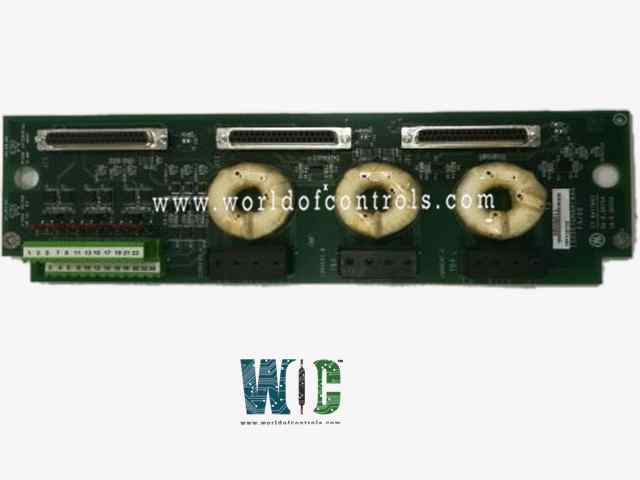
World Of Controls understands the criticality of your requirement and works towards reducing the lead time as much as possible.
IS230TGNAH2A - Turbine-Generator Terminal Board is available in stock which ships the same day.
IS230TGNAH2A - Turbine-Generator Terminal Board comes in UNUSED as well as REBUILT condition.
To avail our best deals for IS230TGNAH2A - Turbine-Generator Terminal Board, contact us and we will get back to you within 24 hours.
SPECIFICATIONS:
Part Number: IS230TGNAH2A
Manufacturer: General Electric
Series: Mark VIe
Product Type: Turbine-Generator Terminal Board
Inputs to TGNA: 3
Generator current inputs: 0 to 5 A
Analog inputs: 4-20 mA
Frame Rate: 600 Hz
Power Requirements: +5 V dc, 6 A
Power supply voltage: 28 V dc
Technology: Surface mount
Operating temperature: -40 to +70°C
Size: 15.9 cm high x 17.8 cm
Repair: 3-7 Day
Availability: In Stock
Country of Origin: United States
Manual: GEH-6721G
FUNCTIONAL DESCRIPTION:
IS230TGNAH2A is a Turbine-Generator Terminal Board manufactured and designed by General Electric as part of the Mark VIe Series used in GE Distributed Turbine Control Systems. The Turbine-Generator terminal board (TGNA) acts as a signal interface board for the Mark VIe I/O pack PGEN. In the Mark VI system, the VGEN board works with TGEN. The TGNA provides a direct interface to three analog inputs for sensing turbine steam pressure and three current transformers (CT) feedbacks for sensing generator current. The three analog inputs are configurable to be 4-20 mA, +/- 5 V, or +/-10 V inputs. There are two jumpers for each analog input. One jumper is used to select either current (4-20 mA) or voltage feedback. The other jumper can optionally ground the return path for the inputs. The three CT inputs can be fed from 1 A or 5 A-rated CT outputs. A separate terminal board point is provided for the two different amp-rated inputs. Configuration parameter CT_Secondary designates which terminal board points are used. The signals are passed on to the Mark VIe I/O packs through a 37-pin connector. The TGNA can be used for either simplex or TMR applications. TMR applications fan the signal to three I/O packs.
INSTALLATION:
Voltage-output sensors should use VDCx and Retx as signal connection points. Jumper JP1(3,5) should be in the voltage I/P position. JP2(4,6) should be in the differential input position for differential feedback and the Return to the GND position for sensors supplied with the 24 V output. Configuration parameter InputUse for the analog inputs should be set according to the type of sensor being used, +/-10 V, +/-5 V, or 4-20 mA. Current-based sensors should use IDCx and Retx as signal connection points. Jumper JP1(3,5) should be in the 4-20 mA I/P position. JP2(4,6) should be in differential input position.
OPERATION:
The three analog inputs accept a 4-20 mA input source available for all three circuits with individual current limits for each circuit. The 4-20 mA transducers can use the +24 V dc source from the turbine control or a self-powered source. A jumper on TGNA selects between current and voltage inputs for each circuit. In a TMR system, analog inputs fan out to the three I/O packs (PGEN). The 24 V dc power to the transducers comes from all three PGEN packs and is diode-shared on the TGNA.
CONFIGURATION:
The terminal board is configured with jumpers. For the location of these jumpers, refer to the installation diagram. The jumper choices are as follows:
WOC has the largest stock of GE Distributed control systems OEM replacement parts. We can also repair your faulty boards and supply unused and rebuilt boards backed up with a warranty. Our team of experts is available round the clock to support your OEM needs. Our team of experts at WOC is happy to assist you with any of your automation requirements. For pricing and availability on any parts and repairs, kindly contact our team by phone or email.
What is the purpose of a turbine-generator terminal board?
The main purpose of a turbine-generator terminal board is to facilitate the transfer of electrical energy generated by the turbine-generator unit to the grid or other loads. It provides a secure and reliable connection point for the transmission of power.
What are the typical components of a turbine-generator terminal board?
A turbine-generator terminal board typically includes terminals, connectors, bus bars, insulators, and other necessary hardware for connecting cables and wires. It may also have protective features such as circuit breakers or fuses to safeguard the equipment from electrical faults.
How does a turbine-generator terminal board work?
When the turbine-generator unit produces electrical energy, it is transferred to the terminal board via conductive cables. The terminal board then distributes this energy to the grid or other equipment by connecting the appropriate terminals. This process ensures efficient and safe transmission of power.